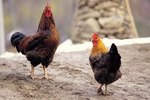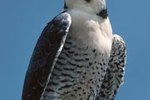
The average African grey parrot (Psittacus erithacus) lives to be more than 20 years old in the wild, and he makes it that far because of various adaptations that help him survive. Many of these adaptations are behavioral and can be traced to his high level of intelligence, which helps him and his flock look out for one another and communicate effectively.
Extreme Intelligence
This parrot is recognized as one of the smartest animals alive, alongside others like the chimpanzee. He has a strong capacity for complex, abstract thought, and can use deductive reasoning to solve problems. This level of intelligence -- not seen in humans until they are between the ages of 3 and 6 -- is instrumental to the African grey's survival in the wild. It is what enables his various behavioral adaptations, like learning from other parrots and his famous skills at vocalizing.
Vocalizing
The African grey's language is highly complex, and he adapts by learning a variety of sounds that help him communicate with his flock. He learns different calls for different situations, like raising the alarm when he sees danger, asking for food and calling for help when he is lost or trapped. The flock, which leaves the roosting site during the day to forage, indulges in periods of vocal communication both in the morning and at night. In captivity, the African grey has demonstrated not only the ability to mimic human speech, but to learn the meaning of different words and form his own sentences.
Learning Life Skills
Because the African grey lives in a large flock, he puts his capacity for learning to use by watching his elders. The younger members of a flock demonstrate respect for and appeasement toward the older members, learning from them the skills that will help them survive. This may include learning how to find water, which animals and potential predators to avoid, how to identify plants that are safe to eat, and how to fight with their beaks and claws.
Strength in Numbers
When the African grey is on the ground foraging for food, he is highly vigilant. The flock as a whole has adapted its behaviors to minimize the risk of foraging on the ground -- it sends search parties to the ground in small groups, while the rest of the flock watches out from a nearby tree. Birds in the trees as well as the ones on the ground carefully watch out for predators. When any one bird in the flock spies danger, he sends out the flock's warning call, signaling to the group on the ground that it should mobilize.
Physical Adaptations
The African grey parrot's physical adaptations are similar to those of other parrots. Each of his feet has two toes that face forward and two that face backward, affording him a strong grip and great control when climbing on branches, vines and ropes. His strong, hooked beak is also useful for climbing, as well as for crushing hard objects like large nuts. Without proper nutrition, however, the beak will soften and flake. Parrots must eat a diet rich in vitamin A-containing vegetables and orange and green fruits to maintain strength of its beak, which is critical to his survival.
References
Photo Credits
-
Jupiterimages/Photos.com/Getty Images
Writer Bio
Tom Ryan is a freelance writer, editor and English tutor. He graduated from the University of Pittsburgh with a degree in English writing, and has also worked as an arts and entertainment reporter with "The Pitt News" and a public relations and advertising copywriter with the Carnegie Library of Pittsburgh.




